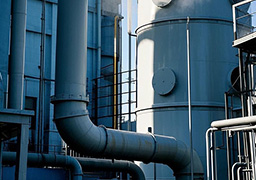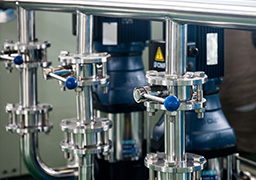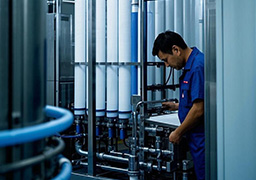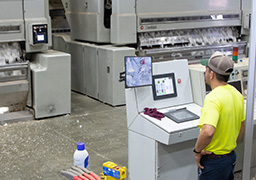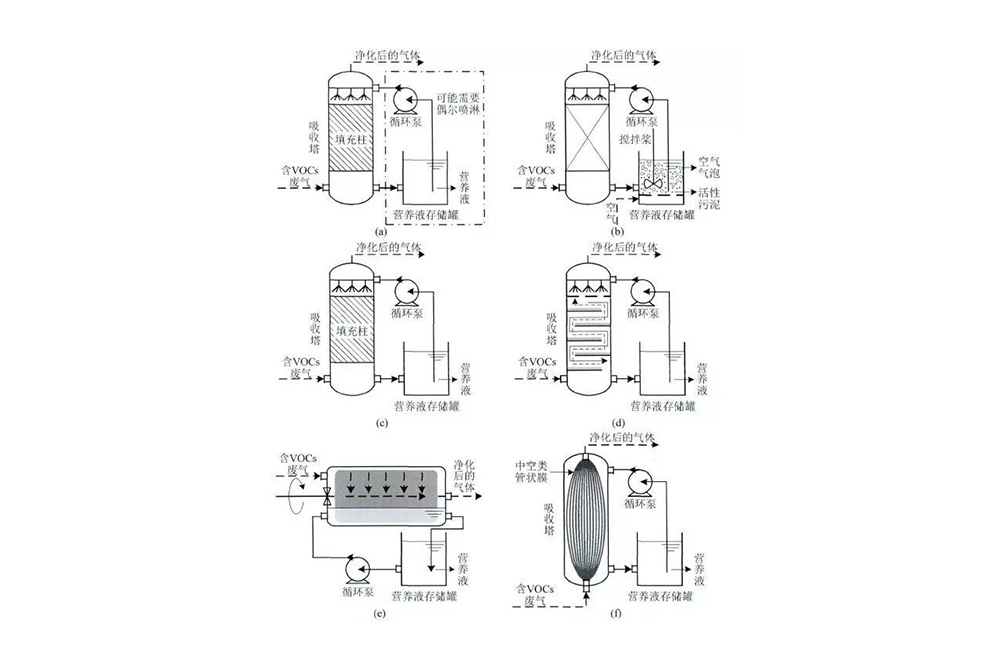Biofiltration
Overview: Biofiltration utilizes the oxidative metabolism of microorganisms to decompose organic pollutants in exhaust gas into harmless or low-risk substances. The interior of a biofilter contains fillers that provide attachment sites for the growth and reproduction of microorganisms. The exhaust gas flows through the filler bed and reaches the biofilm through the diffusion effect of the fillers, where it comes into contact with microorganisms and undergoes oxidative metabolism reactions, thereby achieving the goal of organic waste gas degradation. The emission of volatile organic compounds (VOCs) into the atmosphere can cause serious environmental problems, such as haze, photochemical smog, and the destruction of the ozone layer leading to global warming. Reducing the concentration of VOCs in the environment is a key factor in achieving sustainable development. Traditional treatment processes include physical methods (such as activated carbon adsorption and washing) and chemical methods. Although they have certain removal efficiency, they can generate secondary pollution, such as desorption or direct incineration after activated carbon adsorption saturation, resulting in increased costs. Some chemical reagents used in chemical methods cannot be directly discharged into the environment and need to undergo secondary treatment to meet standards before discharge, making the process complex. Other processes such as combustion or membrane separation have high treatment efficiency and are suitable for treating high concentration organic waste gas. However, their advantages in treating low concentration waste gas are not obvious, and the investment and operating costs are relatively high. Biological methods utilize the oxidative metabolism of microorganisms to treat VOCs, which have the advantages of low cost, good deodorization effect, and no secondary pollution, and have received widespread attention. Based on the advantages of biological methods, they are currently widely used in various fields. The use of biological methods to treat rubber waste gas has a good effect on removing odors; Applied to odor treatment in sewage treatment plants, it greatly reduces investment costs.
The biological treatment technology can be traced back to 1950, initially mainly used to degrade low concentration odorous substances in the air. In 1957, American scientists applied for the first patent for biological treatment of waste gas. From 1970 to 1980, the application of biological methods in exhaust gas treatment attracted attention from countries around the world and rapidly developed in developed countries such as Europe and Japan. In recent years, countries such as the Netherlands, Germany, and Japan have a considerable number of industrial scale biological waste gas treatment devices and have put them into industrial operation. The actual removal rate of pollutants by biological waste gas treatment devices can reach over 90%. Many domestic research institutions, including Tsinghua University, have conducted in-depth research on the biological treatment of organic waste gas, but currently they are mostly in the laboratory stage and have not yet achieved large-scale industrial promotion. However, future biological methods have considerable application prospects in China.
There are currently three mainstream biological treatment processes for waste gas. According to the microbial community and liquid phase form, it can be divided into biological filtration, biological drip filtration, and biological washing processes. At the same time, there are new processes such as rotary drum biofilter, bio plate tower, and membrane biofilm method.
Biological filtration process
The biological filtration process utilizes fillers with strong adsorption capacity, such as pine bark, activated carbon, ceramic particles, compost, etc., to achieve the adsorption of waste gas pollutants. The fillers contain a large number of microorganisms, which absorb and capture pollutants in the waste gas, and complete the degradation of pollutants through microbial metabolism.
In the biological filter process, the exhaust gas is first humidified and then enters the biological filter bed. The moist polluted airflow passes through porous packing with fixed mixed bacterial strains, and after purification, the gas is discharged from the biological filter system. Biofilters generally do not require additional nutrient supplementation (when nutrient deficiency occurs, occasional spraying can be used, mainly to supplement nitrogen or phosphorus sources). This is because the fillers of biofilters are usually soil, compost, peat, sawdust, bark, granular activated carbon, plastic materials, or a mixture of several materials, which provide sufficient nutrients and micronutrients for the growth of microorganisms. Most of the fillers in biological filters contain abundant bacterial strains, and of course, additional microorganisms can also be inoculated. The core of the biological filtration process is the biological filtration bed, and an ideal biological filtration bed should have the following important features: (1) a high specific surface area for microbial membrane growth and gas/biofilm mass transfer; (2) High porosity to promote uniform gas distribution; (3) Good water retention ability to avoid bed dryness; (4) There are effective intrinsic nutrients present; (5) There exists a dense and diverse indigenous microbial community.
The biological filtration process for treating exhaust gas has the advantages of simple process, convenient operation, low operating cost, and good treatment effect. Moreover, the bacterial strains are relatively stable and not easily lost when attached to fixed packing materials. Of course, the biological filtration process also has its own limitations. It is only suitable for treating VOCs with high solubility and easy biodegradability, especially for high concentration waste gas, with poor treatment effect, weak shock load resistance, and the need for regular replacement of filter beds.
Biological washing process
The biological washing process is a suspended activated sludge treatment system consisting of an absorber with inert packing and an activated sludge reactor. The inert packing material inside the absorber is mainly used to increase the contact area between the gas-liquid phase, rather than serving as a carrier for the biological phase. The washing cycle liquid is sprayed down from the top of the absorption chamber, allowing pollutants and oxygen in the exhaust gas to be transferred from the gas phase to the liquid phase through dissolution and adsorption. Some organic matter is directly degraded, while most of the organic matter enters the activated sludge treatment system for degradation. The washing cycle liquid is regenerated through aeration in the activated sludge system. Currently, most biological scrubbers operate with activated sludge from wastewater treatment plants as inoculum.
The advantages of the biological washing process are low resistance and reduced pressure, low clogging of the packing due to its high porosity, no need for regular replacement of the packing, and easy control of the operating process and reaction conditions. However, it is suitable for treating soluble VOCs such as alcohols and ketones (Henry coefficient<0.01), with pollutant concentrations generally below 5000 mg/Nm3 and a small specific surface area for gas-liquid mass transfer (usually<300 m2 · m-3); Due to the large number of operating equipment required for the biological washing process, high operating costs, and unsuitability for treating exhaust gases with high intake flow rates, the application of biological washing process in treating industrial exhaust gases is limited to a certain extent.
Biological drip filtration process
Biological drip filter is a treatment process that falls between biological filtration and biological washing methods. Compared to biological filters, the fillers used in biological drip filters are inert materials such as ceramics, charcoal, polypropylene balls, and granular activated carbon, which cannot provide nutrients for microbial survival and growth. Filler is only used as a carrier for biological growth, but its filler porosity is higher than that of biological filters, with a longer service life and lower fluid resistance. The normal operation of the entire biological drip filter system requires nutrient solution, which is sprayed onto the packing inside the absorption tower through a circulating pump. In addition to some nutrients (mainly nitrogen, phosphorus, and trace elements) in the nutrient solution, it also plays a role in regulating pH and controlling humidity inside the tower. Organic gases also need to be humidified before entering the absorption tower, and then adsorbed and degraded by organisms on inert carriers.
By comparison, biological drip filters can handle a wider range of pollutants and withstand greater pollution loads. This is because the environmental conditions inside the biological drip filter are better controlled, and potential toxic and stubborn metabolites will be removed from the system. It should be noted that the biological drip filter is based on a drip flow mechanism, so this process is more suitable for water-soluble VOCs (Henry coefficient<0.1). Of course, since the contact between microorganisms and pollutants occurs simultaneously, the solubility of VOCs in water is not as high as that required for biological scrubbers. In addition, since the contact between microorganisms and pollutants occurs after VOCs diffuse into the liquid film, the liquid flow rate and circulation speed are considered important parameters affecting the performance of biological drip filters.
The advantage of a biological drip filter is its low operating and investment costs; Easy daily operation; It is possible to artificially add necessary nutrients and adjust the pH value; Suitable for purifying pollutant gases with medium to high concentrations. But there are also its own limitations, such as the blockage of the packing layer caused by the rapid growth of microorganisms inside the tower, the increase in pressure drop, and the decrease in the operating efficiency of the biological drip filtration system. It is necessary to adopt methods such as backwashing to restore the function of the biological drip filtration system. Currently, commonly used methods for preventing and controlling packing layer blockage include flood flushing, acid/alkali backwashing, nutrient restriction, etc.
Biological Plate Tower
The basic structure of a biological plate tower is similar to that of a biological drip filter, except that in the absorption tower, there is no packing material but a pile of parallel circular plates with holes on the boundary. The placement of adjacent circular plates must make the holes alternate and parallel. In this way, the nutrient solution continuously changes direction and flows through each tray from top to bottom, while the gas phase (containing VOCs waste gas) flows in reverse from bottom to top. Biofilm grows parallel to each tray, and the surface of the tray is generally rough, which helps with biofilm adhesion.
The bio plate tower can adjust the total surface area and the space between the trays according to the required operating time, and its constant surface contact area makes it easier to build membranes and scale up during the process. Compared to biofilters and biofilters, biofilters are more convenient for analyzing biological phases and are less prone to clogging caused by excessive microbial growth. Even when the thickness of the tray biofilm reaches its maximum, it is easy to replace and has more stable performance (stable biological activity). It can work for a long time and is also more convenient to operate.
Rotating Drum Biofilter
Similar to biological washing, rotary drum biofilters are also evolved from wastewater biological treatment technology. Its design to some extent solves the inherent problems in biological filters.
The main body of the rotary drum biological filter is a horizontal cylinder, which is installed on two fixed shafts (hollow) at both ends. About 30% to 40% of the cylinder is submerged in the water tank, and microorganisms attach to the rotating drum. After the pollutant gas enters the sealed reactor, it is adsorbed onto the rotating drum medium (such as activated carbon, sponge, etc.). When the drum rotates, microorganisms pass through the water and obtain other nutrients, then decompose pollutants and discharge them from the reactor through the hollow shaft. Structurally, the multi disc type is similar to the single disc type, except that multiple concentric horizontal cylinders are used as carriers for microorganisms instead of a single horizontal cylinder. The hybrid drum biofilter can be seen as a combination of a multi disc drum biofilter and activated sludge process. Unlike the multi disc type, it sets the pollutant inlet below the water surface.
Generally speaking, biomass in rotary drum biofilters is mainly distributed in the outermost layer. The biomass distribution on the outermost layer of the single disc cylinder is uniform, but the biomass shows non-uniform distribution with the depth of the cylinder. In addition to the outermost layer, the biomass distribution in the inner layer of the multi disc is also quite uniform, indicating that it can effectively prevent gas short circuits and achieve better performance. The multi disc rotary drum biological filter can operate for a long time under high pollutant loads and with medium cleaning. But there are no practical examples of this technology being applied in practice yet.
Membrane biofilm reactor
In a typical membrane biofilm reactor, microorganisms attach to one side of the membrane, which serves as a carrier for microbial community growth and provides a huge specific surface area for mass transfer of oxygen and volatile organic compounds. The side of the membrane covered by biofilm is immersed in the liquid phase, which provides nutrients and can control the biological phase. And pollutants in the gas phase diffuse through the micropores of the fiber membrane to reach the biological phase (biofilm), and then aerobic microorganisms use oxygen as an electron acceptor to degrade VOCs. The membrane biofilm method for treating waste gas has the following advantages:
(1) There will be no gas phase blockage and a small pressure drop, but the problem of blockage is more serious in traditional biological methods, especially in biological filters;
(2) It can continuously remove excess biomass, thus preventing reactor blockage under high VOC loads;
(3) Strong shock load resistance, but the maximum pollution load is limited by the membrane limit, while traditional biological methods have poor shock load resistance, which is related to nutritional status. The maximum pollutant load rate is 50-300 g/(m3 · h), 50-2000 ppmv;
(4) It can remove by-products generated during biodegradation, add pH buffering agents to neutralize acidic metabolites, provide nutrients for microbial growth, and serve as a carrier for microbial community growth.
(5) It can remove pollutants with low water solubility such as NO or methane, while traditional biological methods have low removal rates due to limited mass transfer;
(6) The separation of microorganisms from the gas phase prevents microorganisms in the carrier from entering the air, making it suitable for indoor control and management;
(7) At the optimal humidity of the airflow, ordinary organisms require additional humidification devices;
(8) The independent control of gas and liquid phases prevents overflow or foaming, while traditional biological laws largely depend on the operating process.
Compared to the traditional three major bioreactors (biofilters, biofilters, and biofilters), the membrane biofilm method has many advantages, but it is still in the laboratory research stage.




